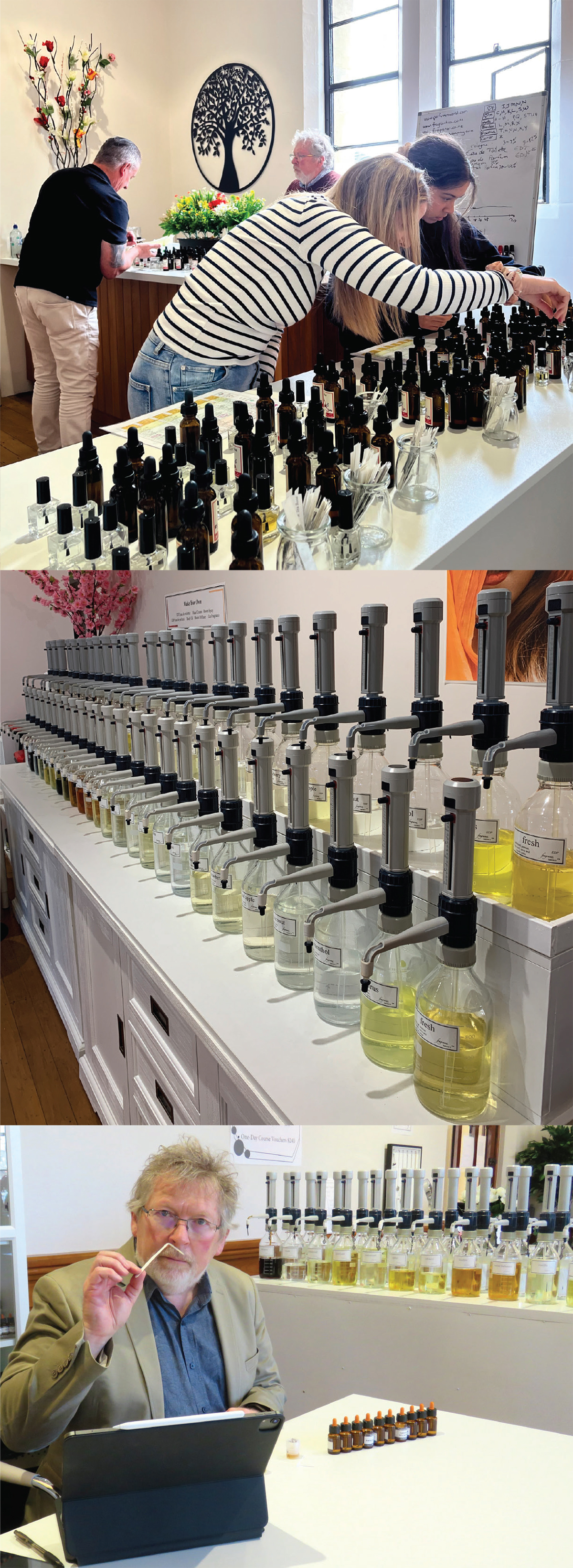
Perfume layering is a technique that involves combining different fragrances to create a one-of-a-kind scent. Just as this principle of layering creates a unique final result, one’s personal experiences and background can be interwoven to form an identity as complex as any bespoke fragrance.
Like a refined perfume, Conan Fee’s career path is a story full of many exciting nuances. After making his mark on engineering education in New Zealand, Fee is now applying his chemical engineering expertise to the captivating world of perfumery. From establishing foundational engineering programs to launching an artisan perfume studio that employs innovative techniques, Fee’s story is a testament to the power of adaptability and a passion for bringing ideas to life.
The early years
Born and raised in New Zealand, Fee began his academic journey at the Univ. of Canterbury. He had initially planned to pursue a civil engineering degree since his sister had studied architecture; however, during his first year, he was intrigued by textbooks on organic chemistry and brain chemistry. As his interests shifted, he found himself drawn to chemical engineering, specifically biochemical engineering. At the time, biochemical engineering wasn’t offered at the university, so Fee had to create his own focus area on biochemistry. “During my chemical engineering days, I studied cell biology and a little bit of molecular biology, and just got into the area of biological applications from a chemical engineering perspective.” After receiving his bachelor’s in chemical engineering, he remained at the Univ. of Canterbury to pursue his PhD in the same field, researching atherosclerosis and blood flow in the arteries.
Following the completion of his PhD in 1989, Fee embarked on a postdoctoral fellowship at the Univ. of Waterloo in Canada. This move proved to be a turning point. It wasn’t merely a change of location; it represented a significant shift in research direction. “I started to think, ‘maybe it’s going to be difficult to live life just looking for research grants,’” recounts Fee. “Whereas if I could do something a bit more industrial, then I might be a bit more secure.” As a result, he shifted his focus to protein purification.
Turning point
After working overseas, he eventually circled back to academia. Upon returning to his home country, he began working at the Univ. of Waikato in 1991 where he was hired to teach process technology. “I was there to teach process engineering,” he says, “but they wanted to call it process technology since they hoped we could teach engineering without math, a forlorn hope.” At that time, there were only two main engineering schools in New Zealand, one at his alma mater and another at the Univ. of Auckland. “It seemed like we might get pushback if we were to launch an engineering degree, so we started with what we called a bachelor of technology, where I taught the process technology stream,” recounts Fee. Over the years of teaching there, and as interest among students grew, so did the number of courses that Fee developed. With the expanded curriculum, the time finally came to push for the establishment of an accredited engineering school. The Univ. of Waikato’s engineering school received accreditation a year after Fee left.
Leading the way
In 2006, Fee returned to the Univ. of Canterbury to teach chemical engineering and assume the role of Deputy Pro-Vice-Chancellor and Dean of Engineering and Forestry. “When I came to Canterbury,” he said, “it was quite a breath of fresh air to have just one cohort and degree that I could really get stuck in.” Here, Fee rekindled his interest in biochemical engineering and, with colleagues from the science faculty, established the Biomolecular Interaction Centre, an interdisciplinary research institute at the university, bridging chemistry, biological sciences, and chemical engineering.
Global humanitarian engineering
In the midst of everything, the 2010–2011 earthquakes hit Canterbury and Christchurch, resulting in over a hundred casualties and damaging many structures, including the Univ. of Canterbury. The earthquakes caused over $50 billion in damage overall, making it New Zealand’s costliest natural disaster. “It was quite a dramatic event,” Fee recalled. “We were teaching in tents for a while.” When the government began allocating funds for the campus’s rebuilding efforts, the university was required to do more than simply restore it to its original state — they were asked to create a curriculum that would provide additional value to the students. After much deliberation, Fee concocted two qualifications: global humanitarian engineering and product design.
The goal of the global humanitarian engineering diploma was to help engineers better understand local communities when navigating disaster zones. Meanwhile, the product design degree aimed to take the overflow of engineering students who had a creative mindset. This degree has three different majors: industrial product design, digital product design, and chemical formulation design.
“As engineers, we get taught how to design a plant to produce a product, but have virtually no idea who would buy the product, where they would buy it, and what it would look like,” explains Fee. “The chemical formulation design major focuses on the product itself.” Encompassing personal care products, agricultural products, cosmetics, and much more, the degree emphasizes not only manufacturing, production, and formulation science, but also brand identity and entrepreneurial thinking. With that, the school of product design was established, making Fee its inaugural head.
From chemical formulation to fragrance
As he was putting together the chemical formulation design program, Fee observed early on that fragrance plays a significant role in a consumer’s purchasing decision. “When choosing deodorant, your buying decision is you tend to pick it off the shelf and smell it. Based on that, you either put it back on the shelf or in your shopping basket.”
This realization sparked his interest in fragrance design and perfumery. He took a course in fragrance design and with his wife, Glenda, opened an artisan perfume studio, Fragranzi, in Christchurch in 2020. Rather than just selling handcrafted fine fragrances, the business offers workshops where people can learn about fragrances and create their own bespoke perfumes. “People want the experience of being creative,” says Fee. “They want something that they can personalize and associate with things they like or things they remember.” After they create their own fragrance, they also receive a unique code associated with their recipe, allowing them the ability to repurchase their creation. Alongside custom perfume creation, Fragranzi offers 24 fine fragrances for sale. Created by Fee, they include masculine, feminine, and unisex perfumes such as Magnolia Café, Nirvana, and Sirocco.

Photos: Fragranzi, the artisan perfume studio in Christchurch, NZ, offers workshops that allow consumers to craft their own perfume from a variety of oils and fragrances available.
Merging science and scent
Passionate about fragrance and its intersection with chemical engineering, Fee infused his own research into the art of perfumery. “The notes that come off a scent strip are driven by mass transfer,” emphasizes Fee. “You have the concentration difference between what’s in the saturated liquid on the strip and what’s in the air, and they come off at different rates.” One of his research areas focused on 3D-printed porous media, which allowed him to devise a method to control the mixing of fragrances at different concentrations based on the exposed surface area of the strip. He employs this method in his perfume studio, and it is currently patent pending.
Fee attributes most of his accomplishments to New Zealand’s isolated geography. “We are so far away from everything that we can think of crazy ideas and just try them out,” says Fee. “Some of them are bound to work which won’t get much traction elsewhere, and then every so often, we come up with something new and fresh for the world. I think that’s an advantage we have down here.”
Looking ahead
Fee plans to continue pursuing his newfound passion at both small and large scales — from conducting research in fragrance design to expanding his business. Fee notes that the only place where one can craft bespoke fragrances using his method is at Fragranzi, and he would love to take it out to other people. Reflecting on his passion for fragrances, Fee adds, “I wish I’d discovered this 20 years ago instead of five years ago, but it’s never too late.”
This article originally appeared in the Profile column in the August 2025 issue of CEP. Members have access online to complete issues, including a vast, searchable archive of back-issues found at www.aiche.org/cep.


